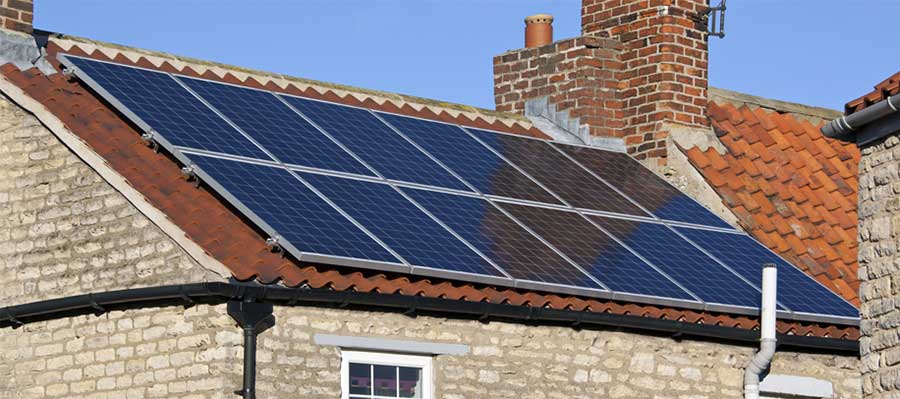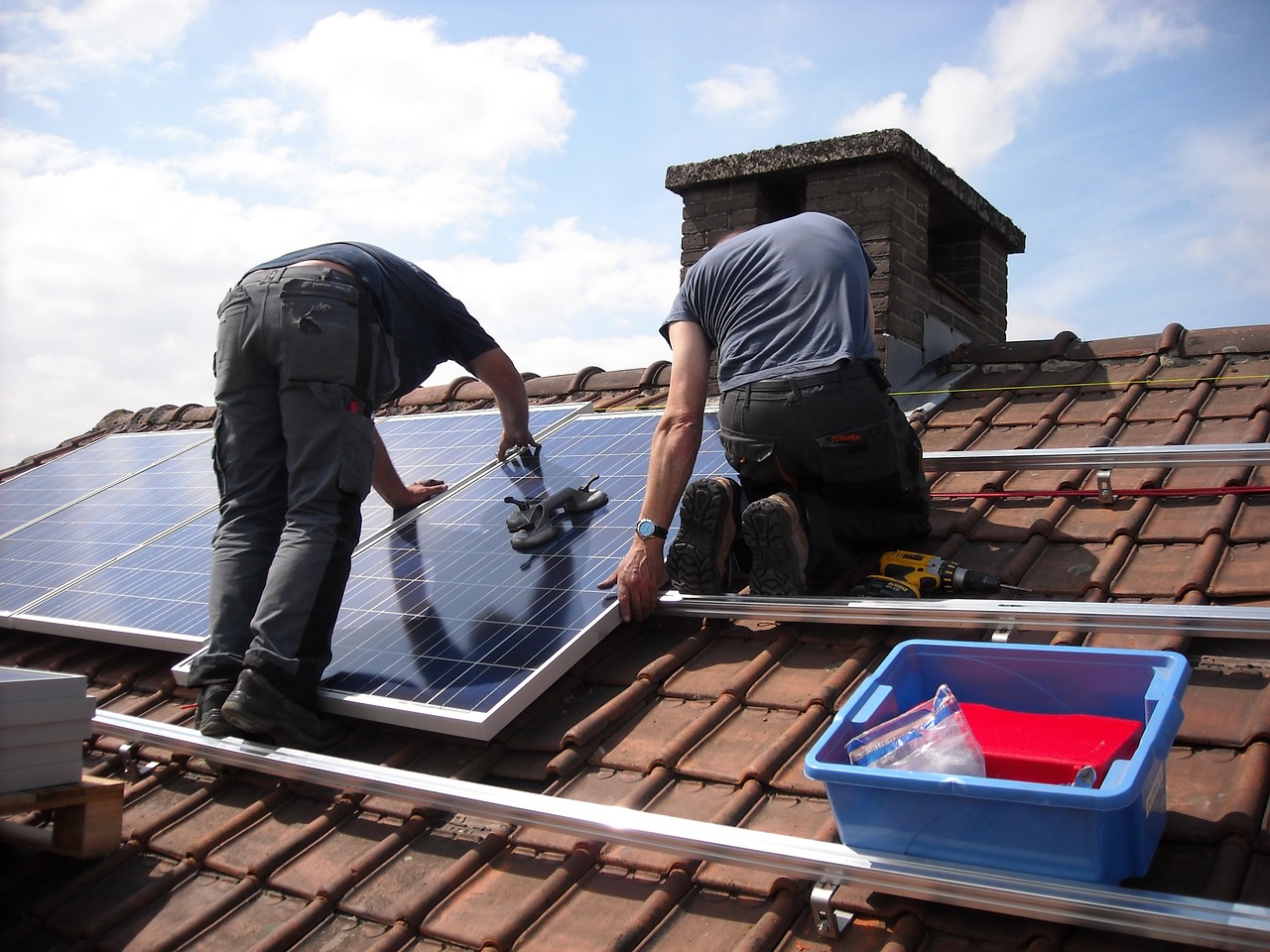- Home
- Scotland's changing climate
- Urban Housing in Scotland
- Maintenance
- Ventilation
- Airtightness
- Insulation
- Lofts - insulation at ceiling level
- Lofts - insulation at rafter level
- Cavity wall insulation
- Solid Walls: Internal vs External Insulation
- Internal Solid Wall Insulation (IWI)
- External Solid Wall Insulation (EWI)
- Timber frame retrofit
- Windows and doors
- Openings in 'historical' buildings
- Openings in 'non-historical' buildings
- Ground floors
- Suspended floors
- Suspended floors - from below
- Suspended floors - from above
- Solid floors
- Insulation materials
- Building science
- Space heating
- Solar energy
- Product Selector
Solar Panel Electricity (Solar PV)
Solar panels convert sunlight into electrical energy through the photovoltaic effect. Solar cells absorb energy from photons, causing electrons to become energised and move within the silicon material. This generates direct current (DC) electricity, which can be collected from solar cells and used to power electrical devices or stored in batteries. The excess electricity can be fed back into the grid through a process known as net metering. Solar panels are most efficient when exposed to direct sunlight.

Retrofitting Solar Photovoltaic Panels
1. Assess the Building's Suitability:
Before starting, determine whether the building is suitable for solar panel installation. Factors to consider include the direction the roof faces, the angle of the roof, and any shading that might affect panel performance. South-facing roofs with minimal shading are ideal.
2. Energy Efficiency Improvements:
Consider making energy efficiency improvements to the home before installing solar panels. This can help reduce energy consumption and maximise solar investment.
3. Get Multiple Quotes:
Contact several accredited solar installation companies to get quotes and assess their recommendations. Ensure the installers are certified by the Microgeneration Certification Scheme (MCS).
4. Planning Permission:
In most cases, installing solar panels on a roof don't require planning permission. However, permission might be needed if the building is listed or in a conservation area. Check with the local council's planning department.
5. Financial Incentives:
Investigate available financial incentives and subsidies, such as the Feed-In Tariff (FIT) or the Smart Export Guarantee (SEG), which may help earn money from the solar panels. These schemes may change over time, so keep updated on the latest options.
6. Select the Solar Panels:
Choose the type and brand of solar panels that meet the home's energy needs and budget. High-efficiency monocrystalline panels are popular for their performance. Discuss options with the installer.
7. Installation:
Once an installer is selected, schedule the installation. A typical residential installation can take a day or two. The installers will secure the panels to the roof, connect them to an inverter, and set up the electrical system to feed the generated electricity into the building.
8. Grid Connection:
Coordinate with the electricity provider to connect to the grid, ensuring that excess energy can be exported and payments received.
9. Safety and Compliance:
Ensure the installation complies with all relevant safety and electrical standards. The installer should handle this, and the system should be certified as safe.
10. Monitor and Maintain:
Once the solar panels are up and running, their performance should be monitored and maintained. Panels should be cleaned periodically, and an eye should be kept on inverter performance.
11. Claiming Incentives:
Register the solar panel system with the appropriate government body or the electricity supplier to ensure any incentives or payments for the energy generated can be claimed.
Remember that the process and regulations may change, so it's essential to consult with local authorities and stay updated on government policies and incentives related to solar PV installations.
But beware.......
Like in many other regions, retrofitting solar PV panels in Scotland has several benefits, such as reducing energy bills and carbon footprint. However, there are also some drawbacks and challenges associated with this process. Here are some of the potential drawbacks of retrofitting solar PV panels in the UK:
1. Initial Cost:
Solar PV panel installation can be expensive. Even though the prices have decreased in recent years, the upfront cost can still be a significant barrier for many homeowners.
2. Limited Sunlight:
Scotland's climate is often overcast and not as sunny as some other regions, which can impact solar panels' efficiency and energy production. This means that the payback period for an investment might be longer compared to sunnier areas.
3. Installation Space:
Many houses in Scotland have limited roof space, and the roof's orientation and shading can affect the panels' efficiency. It's important to have a suitable roof or space for installation.
4. Regulations and Permits:
Local regulations and permitting requirements may need to be navigated, which can add complexity and cost to the installation process.
5. Aesthetic Considerations:
Some homeowners may find solar panels unattractive, and the visual impact on the appearance of a property can be a concern for some.
6. Maintenance and Repairs:
Solar panels require periodic maintenance to ensure they function at their best. While maintenance costs are typically low, they can add up over time.
7. Technology Evolution:
Solar technology is evolving rapidly, and an investment today may be less efficient and cost-effective than newer systems in the future. This can make some homeowners hesitant to commit to solar PV.
8. Return on Investment:
Factors like installation cost, energy prices, and government incentives influence the return on investment for solar panels in the UK. It's essential to calculate whether the long-term savings justify the initial expense.
9. Financing:
Securing financing for solar panel installation can be challenging. While various options are available, not everyone may qualify or find them accessible.
10. Grid Connection:
Connecting solar panels to the grid may require additional costs and approvals from the utility companies.
Despite these drawbacks, solar PV panels in Scotland can still be a wise investment, particularly if tenure is for an extended period. It's essential to carefully consider the costs and benefits, conduct a solar site assessment, and explore available incentives and financing options to determine if retrofitting solar panels is suitable for the specific situation.
